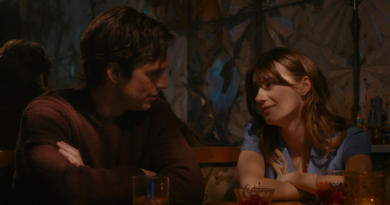In the <i>Ahsoka</i> Premiere, the New Republic Comes With Old Baggage
For the casual fan, it is perhaps possible to forget—amidst the thrill of space flight, the escapism of distant planets, and the endless meme-ability of those alien puppets—that the word “war” defines Star Wars as much as “star.” There are few, if any, Star Wars stories (even those written primarily for children) that operate without the looming threat of societal collapse. Andor, perhaps, is the greatest recent example of these themes on a grounded level. But if Andor was (and is) a series about what’s required for the average person to ignite rebellion, then Ahsoka—the latest of Lucasfilms’ Disney+ experiments—seems poised to explore how such a person can possibly bear the aftermath.
After all, Rosario Dawson’s Ahsoka Tano does not breach the milestone of her own live-action series unencumbered. There’s the character’s baggage to consider: a doomed apprenticeship to Anakin Skywalker (a.k.a. Darth Vader); the trauma of the Clone Wars and the fall of the Republic; the annihilation of her fellow Jedi in the genocide of Order 66; and the battles surrendered and celebrated amidst the Galactic Civil War. Then, of course, there’s the meta baggage to contend with: Numerous animated and live-action series, as well as comic books and a novelization, feed into the debut of Ahsoka on Disney+. The canon is so extensive as to require hours of study, were you to truly devote yourself to the biography of Anakin’s one-time Padawan learner.
Thankfully, Ahsoka does a mostly commendable job of appeasing both ends of the Star Wars fandom spectrum: those with an extensive memory bank on all things Tano, and those grasping the character’s history for the first time. The premiere episode opens with the classic Star Wars opening crawl, informing us that we are entering the era of the New Republic, still in a fledgling state following the recent victories of Luke Skywalker and his fellow Rebel leaders (including some we’ll be introduced to shortly). Ahsoka is on the hunt for Imperial Grand Admiral Thrawn (Lars Mikkelsen)—a beloved Star Wars villain with extensive lore of his own—who could bring what remains of the Imperial Army back into power. Ahsoka believes she’s one step closer to finding Thrawn after having tracked down one of his allies, Morgan Elsbeth (Diana Lee Inosanto), during the events of another Disney+ series, The Mandalorian.
More From ELLE

From Elsbeth, Ahsoka’s learned of a secret map to Thrawn’s location, and in her first scenes of her own TV show, she removes it from “an ancient temple” built by the witch-like Nightsisters of Dathomir. She narrowly escapes some self-destructing droids with the help of her own droid companion, Huyang (David Tennant), who—like Ahsoka herself—was first introduced as a character in animated form, in Star Wars: The Clone Wars. (Without traversing too far into the black hole of Star Wars mythology, it’s important to know two things: Huyang aided the Jedi Order at the height of its strength, and he’s therefore thousands of years old. His protocol runs deep.)
But as Ahsoka and Huyang exit the planet’s stratosphere, they learn that two unnamed villains—both wielding the characteristic red lightsabers of the Dark Side of the Force—have attacked a Republic ship. So Ahsoka goes to meet with General Hera Syndulla (Mary Elizabeth Winstead), a character from the animated series Star Wars: Rebels and a key Republic leader. They both examine the locked orb in which the map is contained, and Ahsoka reveals her concerns that these new Force-using antagonists are accomplices of Elsbeth, and therefore also gunning to find Thrawn. Hera is similarly interested in another possibility: that if the map leads to Thrawn, it could lead to Ezra Bridger.
For those not already acquainted with the animated Star Wars shows, you might want to bookmark Wookieepedia in an effort to distinguish all these characters. (Rest assured, it gets easier.) Ezra (as played by Eman Esfandi in Ahsoka) is another Rebels protagonist, and all you must know about him right now is as follows: He was a Jedi hero who sacrificed himself during the Galactic Civil War; he operated with the crew of the Ghost, which included both Hera and the soon-to-be-introduced Sabine Wren; and his final act of defiance banished both himself and Thrawn deep into hyperspace. Hera and Ahsoka have more than just a political incentive to find Thrawn; they have a personal one. Where Thrawn is, there might Ezra be also.
“You know who could help you with this?” Hera asks Ahsoka.
“I do,” our protagonist replies. “I’m not sure she’ll want to help.”
Of course, they’re talking about Sabine Wren (Natasha Liu Bordizzo), currently speeding away from her boring ceremonial responsibilities on the planet Lothal. A Mandalorian Rebel leader who now operates out of an “old communications tower,” Sabine is not what I’d describe as the tidiest homeowner, but her dusty boxes do reveal an old hologram of Ezra, which she watches as she makes dinner for herself and her (adorable, if unnerving) loth-cat. In this transmission, Esfandi appears, telling Sabine, “You’re like a sister to me. I know your fight isn’t over, and I won’t be there to help you, but I’m counting on you to see this through.”
What, exactly, Ezra wants Sabine to “see through” isn’t clear. Perhaps the Rebellion itself? Consider that checked off the to-do list, sweetie. Regardless, Sabine’s clearly haunted by Ezra’s memory—and the possibility that wherever he might be outside her galaxy, he’s trapped there. So when Ahsoka arrives on Lothal with a lead on Ezra’s location, Sabine agrees to help unlock the space orb-map. (Which, I swear, is a direct rip-off of the space orb-map in another Disney classic, Treasure Planet. But I digress.) Finding Ezra means Sabine’s forced to brush shoulders with Ahsoka, who turns out to be the former’s erstwhile Jedi master. Oh, hey, that’s new!
Rebels fans will likely digest this information with some shock, if not expletive-ridden outrage. In Rebels, Sabine was never a Force-user; her background was in blasters and explosives and other military technology. If she’s now Ahsoka’s one-time Padawan learner (a.k.a. apprentice), then Sabine must have demonstrated some affinity for the Force at one point or another, even if it’s Ezra’s lightsaber with which she sliced and diced. (To be fair, she’d be far from the first Jedi to wield another’s lightsaber: Luke Skywalker used his father’s until he built his own.) It seems possible that Ahsoka noticed Sabine’s dormant Force skills after the collapse of the Empire, decided to train her, and then abandoned the project when her pupil proved too…what? Anakin-like? Sabine would never.
Either way, something went awry between these two, as Sabine is eager to escape her old master’s presence; she swipes the orb-map and takes off for the comfort of her roost. Meanwhile, Huyang runs a scan on the lightsabers used by the aforementioned villainous Force-users, and he learns that one is owned by Jedi Knight-turned-mercenary Baylan Skoll (the late Ray Stevenson), and the other by his apprentice, the blonde-bobbed Shin Hati (Ivanna Sakhno). Naturally, it’s Shin whom Sabine encounters after unlocking the map, Shin who steals it with the help of a few droids, and Shin who stabs Sabine through the stomach after a brief lightsaber duel. Ahsoka arrives just as her former apprentice collapses, a big glowing hole in her abdomen, while Shin heads off into the night sky with the precious map intact—and Sabine’s renderings of its contents destroyed.
’Tis a high-stakes beginning for what Lucasfilm undoubtedly views as a high-stakes investment, grafting much of the franchise’s beloved animated IP onto the unique aesthetic (and visibility) of its live-action films and TV series. Thus far, the Ahsoka experiment is a solid one, though it threatens to boil over from the mix of its many ingredients. As of the end of episode 1, Ahsoka feels promising but unfocused, as yet undecided on its tone or its objectives.
What will ultimately matter most is not, necessarily, how well Ahsoka Tano and her friends slot into the existing New Republic canon. What will determine Ahsoka’s success is how well the series can replicate and expand upon the character dynamics that made the animated shows must-watches, even for those outside the cartoons’ targeted age demographic. The Clone Wars and Rebels were more than adventure-of-the-week programs; they were clever takes on the traumas of war, but rendered in a more youth-friendly manner than, say, Rogue One or Andor. Ahsoka has the opportunity to bridge the distance between these two poles, gifting the cartoon characters with more space in which to clean their deepest wounds—and to build a government that won’t repeat the same brutalities. That, to me, is a premise as exciting as anything Star Wars has teased recently, and a fascinating answer to Andor, in particular.
It remains to be seen if the show can rise to such an ambitious concept. But my hopes were spurred by one specific conversation between Ahsoka and Hera in the premiere episode. As Ahsoka bemoans her former Padawan’s antics, Hera tells her, “I bet your master found you difficult at times.”
After a long, pointed pause, Ahsoka replies: “Anakin never got to finish my training. Before the end of The Clone Wars, I walked away from him. And the Jedi. Just like I walked away from Sabine.”
Hera, gently, says, “I’m sure you had your reasons.”
Ahsoka then sets up what I’m sure will be the theme for the entire series: “Sometimes even the right reasons have the wrong consequences. What do we do then?” If Ahsoka takes that question seriously, it could become much more than the sum of its many parts.
Culture Writer
Lauren Puckett-Pope is a staff culture writer at ELLE, where she primarily covers film, television and books. She was previously an associate editor at ELLE.





